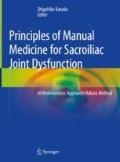Abstract
The randomized-controlled trial (RCT) is used to determine whether one treatment method is better than another. The RCT is indispensable to “evidence-based medicine” (EBM), and serves as a basis for the approval of numerous therapies implemented in modern medicine. The RCT was first reported in 1948 in a study on the use of streptomycin for pulmonary tuberculosis [1].
Access this chapter
Tax calculation will be finalised at checkout
Purchases are for personal use only
References
A Medical Research Council Investigation. Streptomycin in tuberculosis trials committee. Br Med J. 1948;2(4582):769–82.
Guyatt GH. Evidence-based medicine. ACP J Club. 1991;114(Suppl 2):A-16.
Turk DC, Melzack R. Handbook of pain assessment. 3rd ed. New York: Guilford Press; 2010.
Keele KD. The pain chart. Lancet. 1948;2:6–8.
McCormack HM, Horne DJ, Sheather S. Clinical applications for visual analogue scales: a critical review. Psychol Med. 1988;18:1007–19.
Hakata S, Sumita K, Katada S. Efficacy of AKA-Hakata method in the treatment of acute lumbago. Man Med. 2005;43:19–24.
Kogure A, Kotani K, Katada S, et al. A randomized, single-blind, placebo-controlled study on the efficacy of the arthrokinematic approach-Hakata method in patients with chronic nonspecific low back pain. PLoS One. 2015;10:e0144325.
Friedly J, Standaert C, Chan L. Epidemiology of spine care: the back pain dilemma. Phys Med Rehabil Clin N Am. 2010;21:659–77.
Von Korff M, Ormel J, Keefe FJ, et al. Grading the severity of chronic pain. Pain. 1992;50:133–49.
Hestbaek L, Leboeuf-Yde C, Manniche C. Low back pain: what is the long-term course? A review of studies of general patient populations. Eur Spine J. 2003;12:149–65.
The outline of the Comprehensive Survey of Living Conditions 2010. Website of the Ministry of Health, Labour and Welfare. http://www.mhlw.go.jp/toukei/saikin/hw/k-tyosa/k-tyosa10/3-1.html.
Clinical Practice Guidelines for Low Back Pain 2012 (editorial supervisors: the Japanese Orthopaedic Association and the Japanese Society for the Study of Low Back Pain).
Clinical Practice Handbook for Chronic Pain in the Locomotor System (Japanese Orthopaedic Association ed.)
Iwatani T, Tobimatsu Y. Measurement of impediment and activity: evaluation handbook. Tokyo: Nankodo; 2005. p. 213–4.
Fukuhara S, Bito S, Green J, Hsiao A, Kurokawa K. Translation, adaptation, and validation of the SF-36 health survey for use in Japan. J Clin Epidemiol. 1998;51:1037–44.
Fukuhara S, Ware JE, Kosinski M, Wada S, Gandek B. Psychometric and clinical tests of validity of the Japanese SF-36 health survey. J Clin Epidemiol. 1998;51:1045–53.
iHope International. http://www.i-hope.jp.
Author information
Authors and Affiliations
Corresponding author
Editor information
Editors and Affiliations
Rights and permissions
Copyright information
© 2019 Springer Nature Singapore Pte Ltd.
About this chapter
Cite this chapter
Kogure, A. (2019). Evidence of the AKA-Hakata Method. In: Katada, S. (eds) Principles of Manual Medicine for Sacroiliac Joint Dysfunction. Springer, Singapore. https://doi.org/10.1007/978-981-13-6810-3_9
Download citation
DOI: https://doi.org/10.1007/978-981-13-6810-3_9
Published:
Publisher Name: Springer, Singapore
Print ISBN: 978-981-13-6809-7
Online ISBN: 978-981-13-6810-3
eBook Packages: MedicineMedicine (R0)

